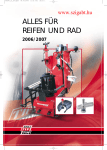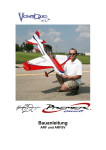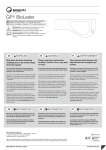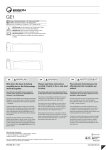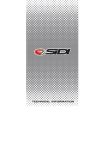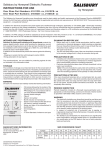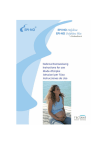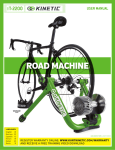Download TP1 Pedal Cleat Tool
Transcript
DE EN WARNUNG TP1 Pedal Cleat Tool Einstellwerkzeug für Pedalplatten Adjustment Tool for Cleats Outil de réglage de cales AVERTISSEMENT Bitte lesen Sie diese Anleitung sorgfältig durch. Bei Fehlmontage droht Sturzgefahr. Please read these instructions carefully. Failure to do so may lead to injury. Pour prévenir toute blessure, lire attentivement les consignes qui suivent. Stellen Sie sich nicht auf das TP1 – Bruchgefahr! Die Einstellung der Pedalplatten selbst erfolgt ausschließlich ohne angezogene Radschuhe. Do not stand on the TP1 – it will break. Setting up shoes with the Cleat Tool is to be carried out with the shoes not on your feet! Ne vous tenez pas debout sur le TP1 - Risque de déchirure ! Le réglage de la cale elle-même se fait exclusivement sans les chaussures. Dieses TP1 ist ausschließlich für die Montage/Einstellung der entsprechenden Pedalplatten vorgesehen. Das Einstellen anderen Pedal-Systeme ist nur mit dem entsprechenden TP1 durchzuführen. Fragen Sie im Zweifelsfall einen Fachmann / eine Fachwerkstatt. This TP1 is only designed to aid in the setup of the stipulated pedal system only. Other pedal systems can be set up using the appropriate TP1 tool. If in doubt please consult a professional bicycle retailer. Ce TP1 est conçu exclusivement pour le montage et le réglage des cales correspondantes. Le réglage d‘autres systèmes de pédales ne doit être effectué qu‘avec leTP1 correspondant. En cas de doute, adressez-vous à un spécialiste / atelier spécialisé. Jegliche Modifikationen dieses Produkts sind unzulässig und können unter Umständen Ihre Sicherheit oder sogar Ihr Leben gefährden. Ein Anspruch auf Sachmängelhaftung ist nach einem unsachgemäßen Gebrauch (Modifikation des Produkts, Nichteinhalten der Warnhinweise dieser Anleitung) nicht gegeben. Bewahren Sie diese Anleitung nach der Montage zum späteren Nachschlagen an einem sicheren Ort auf. Sollten Sie dieses Produkt an eine dritte Person weitergeben, so ist diese Anleitung oder eine Kopie beizulegen. Bei Verlust kann die Anleitung unter www.ergon-bike.com heruntergeladen werden. Reinigung: Schmutz kann einfach mit handwarmem Seifenwasser entfernt werden. Anschließend sollte das TP1 abgespült und abgetrocknet werden. Das Ergon TP1 sollte nicht mit petroleumhaltigen Stoffen wie mineralischen Ölen und Fetten sowie scharfen Reinigern oder sonstigen Chemikalien in Kontakt gebracht werden. Das TP1 sollte nicht in direkter Sonneneinstrahlung lagern. DE – Handbuch zur Einstellung EN – Optimal Cleat Installation Guide FR – Manuel de réglage optimal des cales FR Sachmängelhaftung: Während der ersten zwei Jahre nach dem Kauf des TP1 haben Sie vollen Anspruch auf die gesetzliche Sachmängelhaftung (vormals Gewährleistung). Sollten Mängel auftreten, wenden Sie sich bitte unter Vorlage des Kaufbelegs an Ihren Ergon-Fachhändler. Detailliertere Informationen zur Sachmängelhaftung / Reklamation finden Sie online unter www.ergonbike.com/warranty oder einfach QR-Code scannen. This product must not be modified in any way. Doing so may endanger your safety or life. The product warranty does not cover modified products, or products used in a way not intended or set out in this document. Failure to follow all instructions will invalidate the warranty. Please keep these instructions in a safe place to refer to at a later date. Should you pass the product on to a third person, please include these instructions or a copy thereof. Should you misplace these instructions, a copy can be downloaded at www.ergon-bike.com Cleaning: In order to ensure that your Ergon TP1 provides you with the best performance please clean it using only warm soapy water. Rinse thoroughly using water. Do not use petroleum based products or solvents, oil or grease on this product for any reason. Do not store the TP1 in direct sunlight. Ergon worldwide limited warranty: Ergon warrants to the original retail purchaser that this product is free from defects in material and workmanship for (2) two years from the date of original retail purchase. Please see the current full warranty policy at www.ergonbike.com/warranty or scan QR-code for details. Toute modification de ce produit est interdite et peut le cas échéant mettre en péril votre sécurité, voire votre vie. Un emploi non conforme (modification du produit, nonrespect des avertissements présents dans le présent mode d‘emploi) supprime tout droit à la garantie. Conservez ce mode d‘emploi en lieu sûr après le montage afin de pouvoir le consulter ultérieurement. Si vous devez transmettre ce produit à une tierce personne, veuillez y joindre le présent mode d‘emploi ou une copie. En cas de perte, le mode d‘emploi peut être téléchargé sur www.ergon-bike.com Nettoyage: Vous pouvez enlever la saleté simplement avec l´eau tiède savonneuse. Après cela le TP1 devrait être propre et sec. Veuillez éviter tout contact du TP1 avec des substances contenant du pétrole tout comme des huiles minérales et les graisses, ainsi qu´avec des produits de nettoyage forts ou produits chimiques. Le TP1 ne doit pas être stocké sous contact direct du soleil. Garantie mondiale limitée de Ergon: Ergon garantit à l‘acheteur de détail original que le présent produit est exempt de défauts de matière et de fabrication pendant une période de (2) deux ans à compter de la date d‘achat initiale. Veuillez consulter la politique de garantie complète en vigueur sur www.ergonbike.com/warranty ou scanner votre code QR pour de plus amples informations. Ergon International: RTI Sports GmbH Universitaetsstr. 2, 56070 Koblenz / Germany T +49 (0) 261 899998-28, F +49 (0) 261 899998-19 [email protected], www.ergon-bike.com Ergon USA: 8285 Sunset Blvd. Suite #12 West Hollywood, CA. 90046 T 323-848-4665, T 877-573-7466, F 323-848-9097 www.ergon-bike.com www.ergonbike.com/warranty www.ergonbike.com/warranty www.ergonbike.com/warranty INFORMATION INFORMATION INFORMATION Testfahrt / Feinjustierung: Vor jeder Fahrt die Schrauben auf festen Sitz prüfen. Die erste Testfahrt am besten auf einem Hometrainer/Rollentrainer durchführen. Darauf achten, dass die Kraft effektiv auf die Pedale gebracht wird. Hierbei unterschiedliche Krafteinsätze, Trittgeschwindigkeiten sowie Sitzhaltungen ausprobieren. Die Position der Schuhe mit Hilfe des TP1 entsprechend optimieren, bis sich die Tretbewegung harmonisch anfühlt. Maßgebend ist das eigene Körpergefühl. Hierzu die Einstell-Schritte auf der Rückseite befolgen. Test Riding / Fine Adjustment: Before every ride, check to see if the screws holding the cleats are still tight. The first test ride is best carried out on home trainer / rollers. Pay particular attention to how effectively the power is transferred to the pedal. Try different exercises, cadences, as well as sitting positions. Make small adjustments using the tool until you no longer feel you are working against the springs in the pedals and the pedalling motion feels harmonious. In order to make adjustments, follow the installation instructions on the back side. Die Einstellung anschließend auf einer verkehrsfreien Strecke testen. Das TP1 und ein Werkzeug mitführen. Die Position der Pedalplatten wie zuvor beschrieben prüfen und bei Bedarf nachjustieren. Die Position zuletzt im Gelände (MTB und Cyclo Cross) testen. Bei der Nachjustierung darauf achten, dass die Schrauben gereinigt und gemäß den Pedalplatten-Herstellerangaben angezogen werden. Finally test your setup away from traffic. It is sensible to take the TP1 Cleat Tool with you as well as other tools to make adjustments is needed. If applicable, make a final test off road (MTB/CX). After every adjustment ensure that the cleat bolts are clean are fastened tightly in accordance with the pedal manufacturers instructions. TP1 Ergonomie Handbuch – Online Detaillierte Informationen zum Thema Anatomie und Biomechanik können Sie dem TP1 Online-Handbuch entnehmen: www.ergon-bike.com (Service/Downloads/TP1) besuchen um die Anleitung als PDF herunterzuladen oder QR-Code scannen um direkt zum Download zu gelangen. TP1 Ergonomics Handbook – Online Detailed information about biomechanics and anatomy can be found in the TP1 Online Handbook: Visit www.ergon-bike.com (Service/Downloads/TP1) to download in PDF format. Alternatively use the QR code below. Essai sur route/réglage fin: Avant chaque utilisation, vérifiez que les vis sont bien serrées. Réaliser de préférence le premier essai sur un Home-trainer ou sur des rouleaux. Veiller à ce que la force soit transmise à la pédale de façon efficace. Pour cela, tester les différentes forces, vitesses de pédalage et positions assises. Ajuster en conséquence la position de la chaussure à l‘aide du TP1, jusqu‘à ce que le mouvement de pédalage soit harmonieux. L‘élément déterminant est votre propre sensation corporelle. Respecter pour cela les étapes de réglages présentées au verso. Tester le réglage uniquement sur une voie interdite à la circulation. Emporter le TP1 et un outil. Vérifier la position des cales décrite plus haut et réajuster si nécessaire. Tester en premier lieu la position en tout-terrain (MTB et Cyclo Cross) Lors du réajustement, veiller à ce que les vis soient nettoyées et serrées conformément aux instructions du fabricant des cales. Manuel d‘ergonomie TP1 - En ligne Des informations détaillées sur le thème Anatomie et Biomécanique sont disponibles sur le Manuel TP1 en ligne : rendez-vous sur www.ergon-bike.com (Service/Downloads/TP1) pour télécharger les instructions au format PDF, ou scannez le Code QR pour aller directement sur le téléchargement. Ergon International, RTI Sports GmbH, Universitaetsstr. 2, 56070 Koblenz, Germany. www.ergon-bike.com, info®ergon-bike.com Ergon® is a worldwide trademark. Ergon reserve the right to change any products without prior notice. Druckfehler, Irrtümer und Änderungen vorbehalten. Made in Taiwan. www.ergon-bike.com (Service/Downloads/TP1) ERG_MAN_TP1_02_2014 www.ergon-bike.com (Service/Downloads/TP1) www.ergon-bike.com (Service/Downloads/TP1) www-ergon-bike.com DE – Anleitung zur Einstellung der Pedalplatten 1: Großzehengrundgelenk (breiteste Stelle des Fußes) an der Innenseite des rechten Schuhs ertasten, sowie den Fersenmittelpunkt bestimmen. Die beiden Positionen mit Hilfe der beiliegenden Ergon-Zentriersticker auf der Außenseite des Radschuhs markieren. 1 Längsorientierung: Die Pedalachse soll unter dem Fußballen liegen, da hier die beste Kraftübertragung und Funktion der Muskulatur gesichert wird. Dazu das Großzehengrundgelenk (GZGG) auf der Innenseite des angezogenen Radschuhs ertasten. In der Regel liegt das GZGG an der breitesten Stelle des Fußes (Innenseiten). Versehen Sie den Schuh an dieser Stelle von außen mit einem Ergon Zentriersticker. Die Pfeilmarkierung (Zentriersticker) sollte direkt auf die Orientierungslinie der Pedalachse auf dem TP1 zeigen. 2 Q-Faktor / Stützweite der Füße: Der Q-Faktor gibt an, wie groß die Stützweite der Füße ist. Je enger die Füße am Tretlager liegen, desto besser ist die Kraftübertragung. Daher sollten die Schuhe grundsätzlich so nah wie möglich an den Kurbeln positioniert werden. Werden Überschuhe verwendet, sollte dieser zusätzlich benötigte Raum zur Kurbel berücksichtigt werden. Die auf dem TP1 abgebildete Achse entspricht einer Standard-Achse von 55 mm. Die eigene Achse kann von diesem Wert abweichen. Darauf achten, dass die Schuhe nicht zu nah an der Kurbel liegen und diese beim Pedalieren beschädigen. 3 Fußwinkel: Die Grundposition der Füße sollte möglichst parallel sein. Fühlt sich die Tretbewegung unharmonisch an, dient die persönliche Fußstellung beim Gehen und Stehen als Referenz. Den Schuh geringfügig nach innen oder außen verstellen, bis sich die Tretbewegung harmonisch anfühlt. Diese Justage beträgt in beide Richtungen jedoch nur wenige Grad. Diesen Verstellbereich können Sie am Raster des TP1 ablesen, indem der Fersenmittelpunkt markiert wird. 2: Pedalplatte laut Herstellerangaben montieren, die Schrauben dabei nur leicht anziehen. Die Platte sollte nach dem Anziehen der Schrauben in alle Richtungen beweglich bleiben. 3: Das TP1 aufgeklappt auf eine Tischplatte legen. Den Schuh auf die Oberseite des TP1 setzen. Die Pedalplatte dabei in die dafür vorgesehene Aufnahme stecken. Fersenmittelpunkt Großzehengrundgelenk right 4: Längsorientierung 1 , Stützweite der Füße (Q-Faktor) 2 , sowie Fußwinkel 3 einstellen. Hierzu das Thema “Einstellmöglichkeiten” beachten. Die aufgedruckten Skalen und Zentriersticker helfen bei der späteren Übertragung dieser Werte auf den linken Schuh. 1 5: TP1 und Radschuh über die Tischkante schieben, so dass die Schrauben der Pedalplatte erreichbar sind. Darauf achten dass sich die eingestellte Position des Schuhs dabei nicht verändert. Anschließend die Schrauben leicht anziehen. 6: Den Schuh vom TP1 abziehen und anschließend die Schrauben mit dem vom Pedalplatten-Hersteller empfohlenen Anzugsmoment festziehen. 2 Nm / ft-lb 3 7: Die Pedalplatte wie zuvor beschrieben am linken Schuh montieren. Die Pedalplatte bleibt beweglich. Danach beide Schuhe auf dem TP1 platzieren und in die entsprechenden Aufnahmen stecken. 8: Die Skalen-Werte des rechten Schuhs auf den linken übertragen bzw. die Schuhe symmetrisch zueinander ausrichten. Der rechte Schuh dient hierbei als Referenz. 9: Die Schrauben wie zuvor beschrieben anziehen. Darauf achten, dass sich die Einstellungen hierbei nicht ändern. Abschließend die Schrauben mit dem vom PedalplattenHersteller empfohlenen Anzugsmoment festziehen. Bei anschließenden Feineinstellungen, z.B. nach einer Testfahrt, die Schritte 2-9 bis zur bevorzugten Einstellung wiederholen. Hierzu das Thema “Testfahrt / Feinjustierung” auf der Frontseite beachten. left right left = Nm / ft-lb EN – Instructions for installation of cleats 1: Find the joint for the big toe (the widest part of the foot) by putting the shoe on and feeling through the shoe. Also find the middle point of your ankle. Mark these two positions using the provided Ergon pointer stickers on the outside of the shoe. 1 Fore / Aft positioning of the cleat For efficient power transfer from your muscles the cleat should be positioned so that the pedal axle is under the ball of the foot. To do this while wearing shoes, simply find the joint at the base of your big toe. In general the big toe joint is at the widest part of the foot. Mark this point using an Ergon Reference Point sticker. The arrow (pointer stickers) should point directly down at the reference line for the pedal axle as marked on the TP1. 2 Q-Factor / Foot Stance The Q-Factor is the value given to the stance of your cranks and feet. This width in general should be small - the closer your feet are to the bottom bracket the better. The shoe should pass as closely as possible to the crank. The Ergon TP1 can help set this distance. Please note that if you are to ride with overshoes, then adjustments may be required accordingly. The axle on the pedal diagram pictured on the TP1 tool is a standard axle measuring 55mm. It is possible that your pedals have a longer or a shorter axle. Attention should therefore be paid to the shoe and the crank arm not touching to avoid damage. 3 Adjustment of the foot angle (foot rotation) The basic position of the feet should be parallel to each other. The correct position on the TP1 for this foot position is between the centre line and the Achilles tendon. Fine adjustment of this position should be made to ensure that the pedaling motion feels comfortable. The shoe can be turned slightly inwards or outwards to achieve this, however the rotation should be no more than a few degrees. The markings on the Ergon TP1 allow this angle to be recorded as the heel’s mid point is marked. 2: Fit the cleats according to the instructions provided by the manufacturer. However do not tighten them. It should be possible to move the cleat on the bottom of the shoe. 3: Open the TP1 and place is on a table top. Fit the cleat on the bottom of the shoe to the cut-out on the tool. Middle point of your ankle Joint for the big toe right 4: Adjust the fore/aft 1 , stance (Q-Factor) 2 , and angle of the foot 3 . Pay attention to the section ‘installation information’. The printed scales and the pointer stickers will help you translate the position to the other shoe. 1 5: Slide the TP1 and the shoe over the edge of the table, so that you can get at the screws from below. Be sure not to change the position of the shoe. Now tighten the screws. 6: Remove the shoe from the TP1 and check that the screws are tightened to the correct torque setting as stipulated by the shoe / pedal manufacturer. 2 Nm / ft-lb 3 7: Repeat the process for fitting the cleats to the other shoe, then fit both shoes to the TP1 tool. 8: Transfer the position from the first shoe to the other shoe using the grid on the TP1 for reference. This will give you a symmetrical fit. 9: Tighten the screws as before to the correct torque setting as stipulated by the shoe / pedal manufacturer, again paying attention to not move the cleats in the process. Finally it is time to test ride, following which it may be necessary to repeat steps 2 – 9. For more information please see the section ‘Test Ride / Fine Adjustment’ on the front side. left right left = Nm / ft-lb FR – Consignes de réglage des cales 1: Palpez l’articulation principale du gros orteil (point le plus large du pied) à l’intérieur de la chaussure droite et déterminer le point central du talon. Repérer ces deux positions avec la bande de marquage Ergon sur l’extérieur de la chaussure. 1 Orientation longitudinale de la cale L’axe de pédale doit être en dessous de la plante antérieure du pied car c’est ainsi que la force est la mieux transmise et que les muscles fonctionnent au mieux. Palpez l’intérieur de la chaussure à la recherche de l’articulation principale du gros orteil. Autre repère : ce point se trouve généralement à l’endroit le plus large du pied. Placez à cet endroit une bande de marquage Ergon. La flèche doit pointer directement vers la ligne d’orientation de l’axe de pédale de TP1. 2 Facteur Q / Distance entre les appuis des pieds Le facteur Q indique la distance entre les appuis des pieds. Plus les pieds reposent étroitement contre le pédalier, meilleure est la transmission de la force. Les chaussures doivent donc être positionnées aussi près que possible des manivelles. TP1 permet tout simplement d’optimiser cet écartement. Si vous utilisez des couvrechaussures, tenez compte de l’espace supplémentaire nécessaire par rapport à la manivelle. L’axe représenté sur le TP1 correspond à un axe standard de 55 mm, l’axe personnalisé peut présenter un écart avec cette valeur. Veiller à ce que les chaussures ne se trouvent pas trop près de la manivelle et qu’elles ne l’abiment pas pendant le pédalage. 3 Réglage de l’angle de pied La position de base des pieds doit être parallèle lorsque vous pédalez. L’axe imaginaire entre le point central et le tendon d’Achille est déterminant ici. L’angle de pied pourra être modifié ultérieurement lors du réglage de précision, jusqu’à obtention d’un mouvement de pédalage harmonieux. La chaussure pourra alors être légèrement décalée vers l’intérieur ou vers l’extérieur. Cet ajustement ne se fait que sur quelques degrés, dans les deux directions. Vous trouverez la plage d’ajustement sur le quadrillage de TP1, avec comme point de repère le point central du talon. Articulation principale du gros orteil 2: Monter la cale en respectant les instructions du fabricant sans serrer complètement les vis. Une fois les vis serrées, la cale doit rester mobile dans toutes les directions. 3: Poser le TP1 déplié sur une table. Placer la chaussure sur la face supérieure du TP1. Clipser la cale sur le support prévu à cet effet. Point central du talon right 4: Régler l’orientation longitudinale 1 , la distance entre les appuis des pieds (Facteur Q) 2 et l’angle de pied 3 . Suivre la rubrique “Possibilités de réglage” Les échelles imprimées et la bande de marquage sont utilisées pour le transfert ultérieur de ces valeurs sur la chaussure gauche. 1 5: Faire glisser le TP1 et la chaussure sur le bord de la table pour pouvoir accéder aux vis de la cale. Veiller à ne pas modifier le réglage de la position de la chaussure. Serrer ensuite légèrement les vis. 6: Retirer la chaussure du TP1 puis serrer les vis au couple recommandé par le fabricant des cales. 2 Nm / ft-lb 3 7: Monter la cale sur la chaussure gauche comme décrit plus haut. La cale reste mobile. Placer ensuite les deux chaussures sur le TP1 et les clipser sur les supports correspondants. 8: Transférer les valeurs de l’échelle de la chaussure droite sur la chaussure gauche, ou orienter les chaussures symétriquement l’une par rapport à l’autre. La chaussure droite sert de référence. 9: Serrer les vis comme décrit plus haut. Veiller à ne pas modifier les réglages. Serrer ensuite les vis au couple recommandé par le fabricant des cales. Lors des réglages fins qui suivent par exemple un essai sur route, reprendre les étapes 2-9 jusqu’à l’obtention du réglage voulu. Suivre la rubrique “Essai sur route/ réglage fin” sur la première page. left left right = Nm / ft-lb



